
If you’re shopping for a Hyundai Santa Fe, the transmission situation might feel confusing right now. While some regions continue with dual-clutch technology, Hyundai is making significant changes to address reliability concerns that have affected many owners.
Understanding the Current Santa Fe Transmission Landscape
The story of the Santa Fe’s transmission is one of technological ambition meeting real-world challenges. Currently, the 2025 Santa Fe comes with an eight-speed dual-clutch transmission (DCT) paired with the turbocharged 2.5-liter engine. This setup delivers 277 horsepower and 311 pound-feet of torque, providing solid performance for family hauling and light towing duties.
However, this transmission has become a source of frustration for many owners. The dual-clutch system, while designed to offer quick shifts and better fuel economy, has struggled with reliability issues that have prompted multiple recalls and warranty repairs.

What Went Wrong with the Dual-Clutch System
The problems with Hyundai’s eight-speed DCT aren’t just minor inconveniences. A major recall affected 12,349 vehicles due to software logic errors that could disengage clutches and damage the transmission case. Some owners have experienced complete transmission failures with relatively low mileage, leading to lengthy repair times and frustrating experiences.
Beyond catastrophic failures, the DCT has shown behavioral issues that affect daily driving. Many drivers report jerky operation at low speeds, delayed responses during rolling stops, and occasional clunky shifts that make the driving experience less refined than expected in a family SUV.
The Big Change Coming for 2026
Recognizing these problems, Hyundai is replacing the dual-clutch transmission with an eight-speed torque converter automatic for the 2026 Santa Fe. This decision represents a significant shift in strategy, moving away from the complex DCT technology to a more conventional and proven transmission design.
Why the Switch Makes Sense
The move to a torque converter automatic addresses several key issues:
Reliability: Traditional automatics have decades of proven reliability in family vehicles. They’re less complex and more forgiving of varying driving conditions and maintenance schedules.
Smoothness: Torque converter transmissions typically provide smoother low-speed operation, eliminating the jerky behavior that has plagued the DCT system.
Service Network: Most technicians are more familiar with conventional automatics, making service and repairs more accessible and potentially less expensive.
Towing Performance: For families who need to tow trailers or boats, traditional automatics often handle the heat and stress of towing better than dual-clutch systems.
What This Means for Different Buyers
| Buyer Type | Recommendation |
|---|---|
| 2025 Model Shoppers | Consider waiting for 2026 or look at Santa Fe Hybrid (uses 6-speed automatic) |
| Used Car Buyers | Carefully research transmission history and consider extended warranties |
| Current Owners | Stay current with recalls and maintenance; consider trading before major issues |
| Performance Seekers | Look at other brands with proven DCT systems or wait for 2026 updates |
Regional Differences and Market Variations
While the U.S. market is moving away from the dual-clutch system, some international markets may continue using DCT technology in certain configurations. This creates an interesting situation where the same model year could have different transmissions depending on where it’s sold.
The Hybrid Alternative
Currently, the Santa Fe Hybrid uses a different powertrain setup with a six-speed automatic transmission that hasn’t experienced the same reliability issues. This might be worth considering for buyers who want a 2025 model but are concerned about the DCT.
What 2026 Brings
The 2026 Santa Fe represents more than just a transmission change. Hyundai is positioning this as offering “ideal overall drivability” with the new torque converter system. Early indications suggest this should result in a more refined, reliable driving experience that better matches what families expect from a three-row SUV.
Making the Right Decision for Your Family
For most families, the upcoming transmission change is positive news. It suggests Hyundai is listening to customer feedback and prioritizing reliability over theoretical performance advantages. The dual-clutch system may have offered marginally better fuel economy and quicker shifts in ideal conditions, but these benefits were overshadowed by reliability concerns and poor low-speed behavior.
Frequently Asked Questions
Q: Should I avoid 2024-2025 Santa Fe models with the DCT?
A: Consider the hybrid model or wait for 2026 if transmission reliability is a priority.
Q: Will the new automatic be less fuel efficient?
A: Modern torque converter automatics are very efficient; any difference should be minimal.
Q: Are current DCT problems covered under warranty?
A: Yes, major issues are typically covered, including complete transmission replacement when necessary.